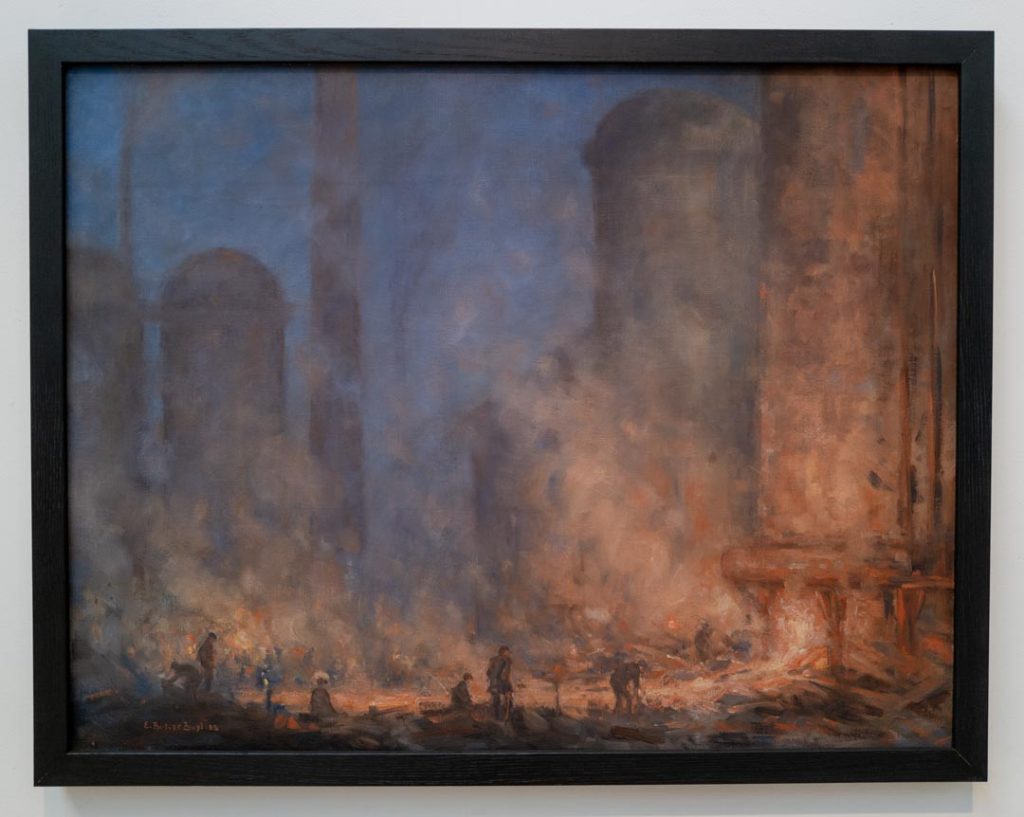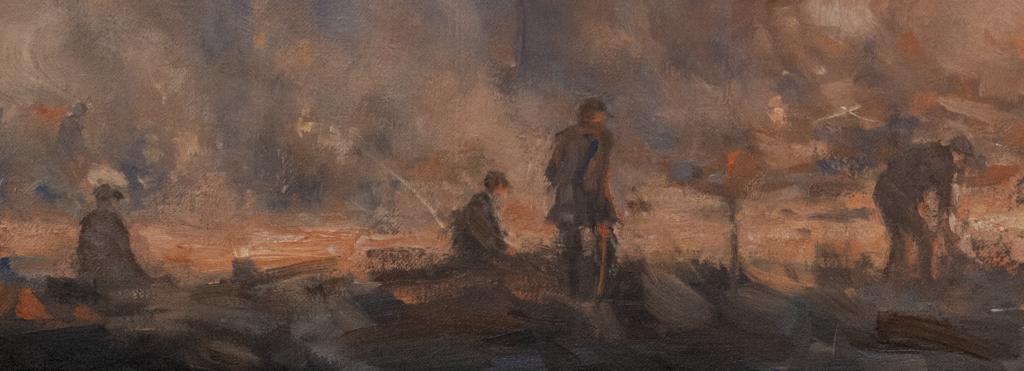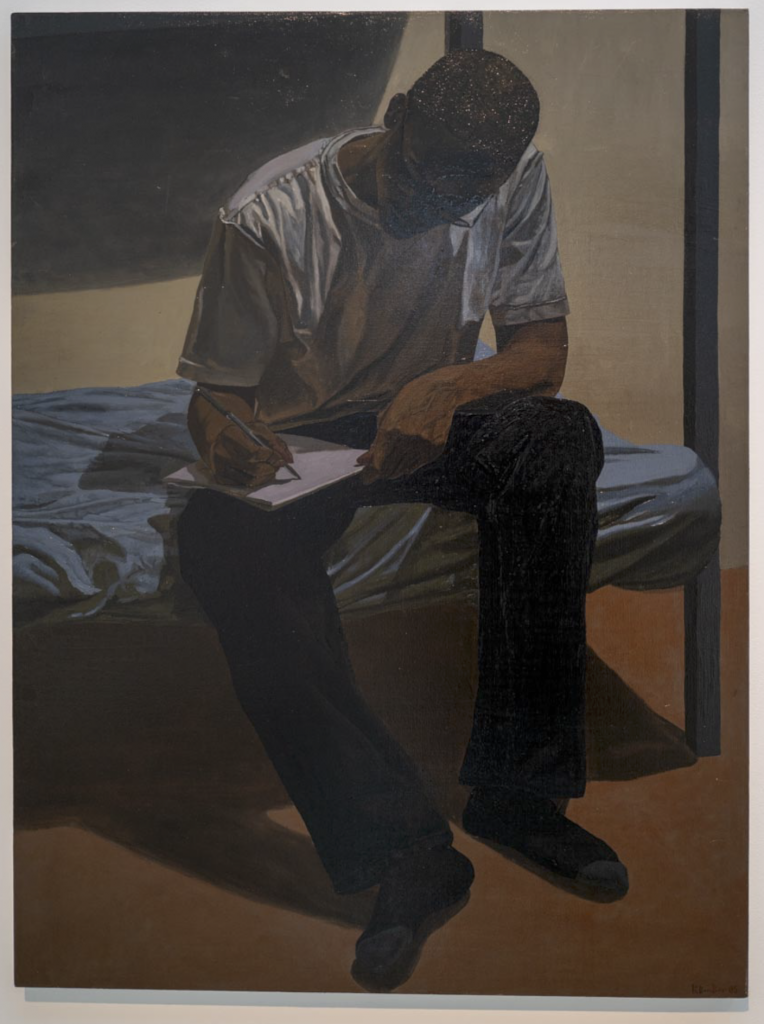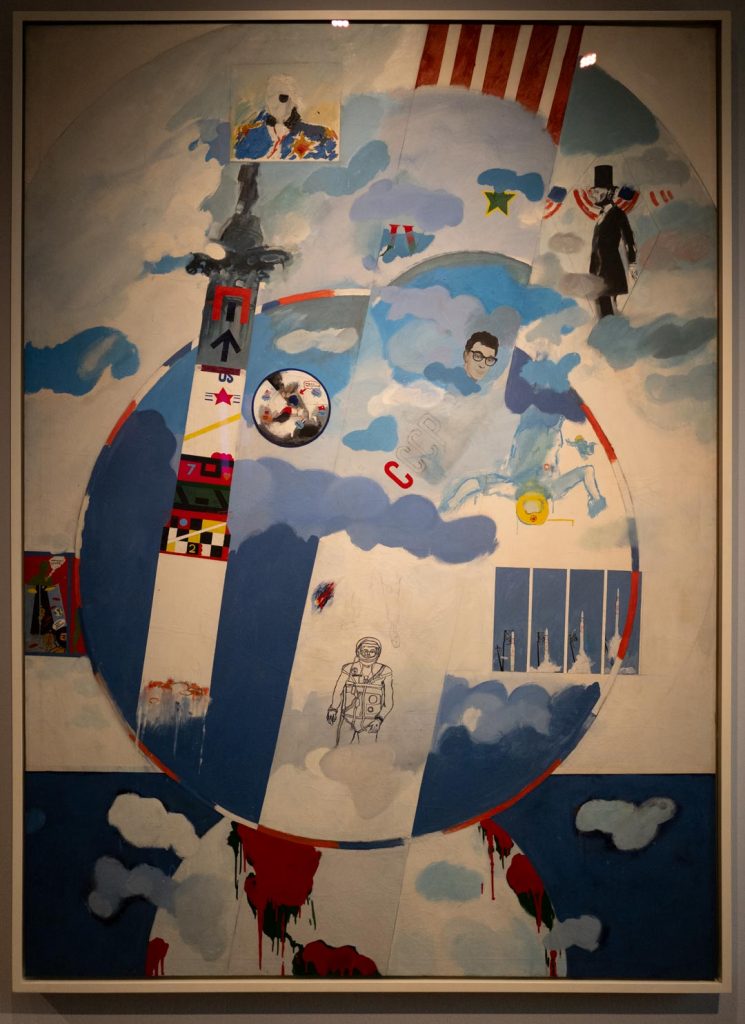After visitng the art gallery I took the photos home of the art that we’d seen in the galleries and I sat down to listen to them, to see what they might allow me to pull out of the frame in terms of feelings, and sounds.
Artwork One – Pig Bed – Tapping A Furnace, Edwin Butler Bayliss, 1874-1950
The first image I chose to look at and listen to is this large painting of a 19th century scene showing the workers in an industrial environment during the industrial revolution tapping a furnace to release the molten iron probably into the “pigs”. Pigs are the moulds that molten metal is poured into before it is moved into another location where it can be melted down and used for casting into iron components such as those that are used in some of the most famous bridges and structures in the UK.

What is the sound that precedes the image?
For me the sound that precedes this is the sound of many people shouting and organising their timings to collaborate to get the job done. There is a sound of hammering from people preparing the foot of the furnace. The sounds of flames and crackling of the fuel, whether it’s coke, coal or something else. People coughing because of the overwhelming fumes and smoke which are being emanated from the processes. I wonder whether the subjects were suspicious of the artist sitting there sketching the scene also, maybe asking him questions about what he was doing.
What can you see?
All around the smaller figures in the foreground are large furnaces which will be used to smelt the iron to be used in later industrial applications. The lack of light might tell us it’s night time or early evening, or even that the background appears darker because of the bright fire in the front of the image. It looks like the subjects are mainly men and all appear to be wearing flat caps and no safety equipment. The actual painting is detailed but the figures are not massively detailed and is made using some expressive brush strokes that are massively suggestive and produce a wonderful impression of the scene in front of the artist.

What can you touch?
I feel like I can go towards the bases of the furnaces and warm my hands as if I’m in front of my Nan’s old coal fire. The ground looks uneven to walk on and I’m frightened that I’ll trip over if I walk towards the people.
What can you feel?
In terms of feeling something, and Sylvia mentioned that it’s feeling in a spiritual sense, I feel a sense of fear for myself and for the people in the image. I work in engineering and health and safety standards today are much better than they were in the time of the original painting. Today, these people would be covered with thermally insulated clothing and protective breathing apparatus to prevent an over exposure to the workers’ lungs. I feel an overwhelming pressure from the molten metal filled furnaces. Energy being expelled from the fuel and the people working fills the air too as well as the tiredness of the workers weighing them down.
What can you hear?
I can hear the banging and crashing of people moving the pigs of cast iron around as well as the breaking open of the bottom of the furnace to release the molten iron. The changes of temperature of the pigs and the other components once the molten metal hits it expands and causes some big noises and bangs and cracks. The sighing of the workers as they hope for the day to come to an end along with their bad chests from the years of inhaling soot and small components of the slag that separates from the iron ready to be tapped off or scraped from the surface.
Artwork Two – Still Life by Kimathi Donkor 2015

What is the sound that precedes the image?
For me the sound that immediately precedes this image would be the sound of the strong door closing behind the prisoner, his feet shuffling across to the bed with his writing materials, muttering to himself about the contents of what he was about to write.
What can you see?
The image is a simple scene of a young man sat on the bottom bunk of a seemingly institutional bed. The simplicity of the clothes, bedding and the stark decoration would point at it being a prison cell, which is confirmed by the artist’s statement. The subject has no shoes on so he’s not planning on going anywhere for some time and he’s beginning to write a page of something, whether it’s a letter to family, an essay for an educational programme, a journal or even poetry.
What can you touch?
The harshness of the bed sheets or covers that the subject sits on speak of an industrial scale laundry. The floor is cold and walls featureless so everything is shiny and textureless as is the cold steel of the bunk bed legs. His white shirt, jeans and socks are rough to the touch too as it is part of the same laundry process as the bedding. The paper and pen are standard fare from any stationery shop and appear to be important to the subject as there are no other personal possessions in view.
What can you feel?
With regards to an emotional feeling, there is an sense of homesickness and loneliness. The unrelenting feeling of being isolated from the world around him and the only way to make sense of it all is by writing his thoughts down. Regret that he is in this place and a sense of fear for his future seep out of the painting to me but this might be my psychological interpretation of the scene.
What can you hear?
I can hear the scratching of the biro on pad of paper, the breathing of his cellmate up on the top bunk of the bed and the sound of other inmates chatting to each other through the walls and an occasional pop song coming across from someone else’s radio. The shiny floor and socks moving around on them make a hissing sound whilst the bed sheets crinkle like crispy material that’s been left out in the sun too long, after being subjected to the harsh industrial laundry processes.
Summary
This is a tricky exercise for me, as it sounds counterintuitive to “Listen” to a photograph. I understand that in the last two years of Level 4 we were taught to “Read” photographs and whilst this is a similar task the fact that we were thinking about listening was difficult to get my head around. Also making the task trickier for me was the fact that there were no photographs to look at in the exhibition spaces that were open on the day. I selected the two paintings as they provided a soundtrack to me.
I looked at each of the images as we were travelling around the galleries and the first I noticed was the Edwin Butler Bayliss painting of the typical industrial revolution scene. The soundtrack to this painting for me sounds like the Jean Michel-Jarre track “Industrial Revolution” with massive hammers hitting on massive anvils as well as big bass notes from massive machines. It reminds me of our family trips to Ironbridge and the Blists Hill Victorian Town museum as well as the Black Country Living Museum.
The second painting I selected by Donkor was a challenging image as it didn’t have a hugely loud soundtrack in my mind. I use movies a lot to make sense of the world and associate events and situations to films. Some of the movies that sprang to mind when viewing this painting were The Green Mile, Lock Up and even some TV shows like Porridge and Time. Reading the artist’s statement tells us that it was a painting of a prisoner but modelled on someone who is not a prisoner, so the feelings “felt” and sounds “heard” are a product of the presentation of the painting and the emotion wrapped up within it.
There were many other pieces of artwork that contained lots of noise and sounds but it was all too chaotic for me to make any sense of. A typical example of this would be the Boshier painting ” I Wonder What My Heroes Think Of The Space Race” from 1962

The painting is one that interests me but it feels like a collage of scenes rather than a single event that contains a sound before it’s creation. If I were to “listen” to this work I would be hearing national anthems of the old Soviet Union and United States Of America, as well as the sounds of huge rockets leaving the Earth’s gravitational influence.
Be First to Comment